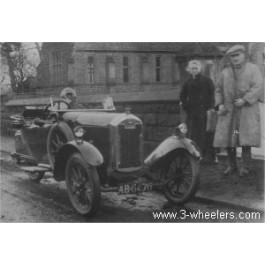The Castle Three Motor Company were based in Kidderminster, Worcestshire. (UK) and they tried to create a vehicle that did not have the “spindley” cycle car image and they wanted to make the 3 wheeler more “civilised”.
In 1919 they produced their Castle Three. This car was an attempt to rival Morgan as it was described as having “that proper car look”. It was fitted with a four cylinder side valve, water cooled, 1094cc Dorman engine which was later uprated to a four-cylinder 1207cc, 9hp Peters engine.
The car had all the equipment of a “real car” with dynamo lighting, spare wheel and tyre and steel artillery wheels instead of the usual wire or wooden disc. The wheels were advertised as being fully interchangeable. In their attempt to create a true car 3-wheeler the the vehicle was extremely heavy, this unfortunately meant that it exceeded the weight limit to make it qualify for a lower tax. It was also the most expensive 3-wheeler being priced at £295 and so any advantages a buyer may have gained in buying a 3-wheeler they lost in extra fuel consumption, no tax reduction and purchase price. The transmission on these cars did cause serious setbacks for the company which later when combined with other problems ceased manufacturing after only 350 vehicles were produced. To date only two vehicles are known to have survived.
In 1922 the company introduced a 4-wheeler called the Castle Four.



